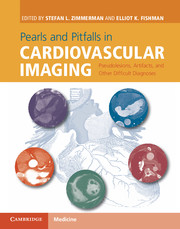 Pearls and Pitfalls in Cardiovascular Imaging
Pearls and Pitfalls in Cardiovascular Imaging from Section 11 - Veins
Published online by Cambridge University Press: 05 June 2015
Imaging description
May–Thurner syndrome, also known as iliac vein compression syndrome, or Crockett syndrome, is symptomatic compression of the left common iliac vein between the right common iliac artery and the lumbar vertebrae. Axial CT images will show that the right common iliac artery compresses the left common iliac vein (Figures 97.1 and 97.2). Patients with May–Thurner syndrome have an asymmetrically small left common iliac vein, which measured an average of 3.5mm in diameter in a study of 10 patients by Oguzkurt et al., which was significantly smaller than that in control subjects (11.5mm). The abnormality can be confirmed by iliac venography obtained via femoral access, which will demonstrate compression of the left common iliac vein in association with a pressure gradient (Figure 97.1). Patients with May–Thurner syndrome have a higher risk for acute or chronic deep venous thrombosis of the left-sided lower extremity (Figure 97.1). In patients with May–Thurner syndrome with chronic left common iliac venous occlusion, tortuous pelvic venous collaterals, which may connect to the contralateral veins, may be seen (Figure 97.2).
Importance
May–Thurner syndrome is important to recognize in patients with persistent left leg edema because relief of the mechanical compression of the left common iliac vein can prevent the development of deep venous thrombosis and venous insufficiency. Endovascular treatment with angioplasty and stent placement has been shown to be a safe and effective means of treating May–Thurner syndrome.
Typical clinical scenario
Patients with May–Thurner syndrome may present with acute or chronic left leg edema, limb pain, venous claudication, varicosities, deep venous thrombosis, chronic venous stasis, ulcers, phlegmasia cerulea dolens, or pulmonary embolism. This condition has been estimated to occur in 2% to 5% of patients who undergo evaluation for lower extremity venous disorders. It occurs predominantly in young to middle-aged women.
Contrast-enhanced CT or MRI typically shows external compression of the left common iliac vein caused by the right common iliac artery.
To save this book to your Kindle, first ensure [email protected] is added to your Approved Personal Document E-mail List under your Personal Document Settings on the Manage Your Content and Devices page of your Amazon account. Then enter the ‘name’ part of your Kindle email address below. Find out more about saving to your Kindle.
Note you can select to save to either the @free.kindle.com or @kindle.com variations. ‘@free.kindle.com’ emails are free but can only be saved to your device when it is connected to wi-fi. ‘@kindle.com’ emails can be delivered even when you are not connected to wi-fi, but note that service fees apply.
Find out more about the Kindle Personal Document Service.
To save content items to your account, please confirm that you agree to abide by our usage policies. If this is the first time you use this feature, you will be asked to authorise Cambridge Core to connect with your account. Find out more about saving content to Dropbox.
To save content items to your account, please confirm that you agree to abide by our usage policies. If this is the first time you use this feature, you will be asked to authorise Cambridge Core to connect with your account. Find out more about saving content to Google Drive.